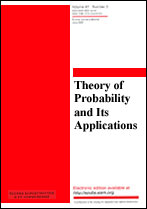|
This article is cited in 1 scientific paper (total in 1 paper)
Weighted Poisson–Delaunay mosaics
H. Edelsbrunner, A. Nikitenko
Institute of Science and Technology Austria, Klosterneuburg, Austria
Abstract:
Slicing a Voronoi tessellation in $\mathbf{R}^n$ with a $k$-plane gives
a $k$-dimensional weighted Voronoi tessellation, also known as a power diagram
or Laguerre tessellation. Mapping every simplex of the dual weighted Delaunay
mosaic to the radius of the smallest empty circumscribed sphere whose center
lies in the $k$-plane gives a generalized discrete Morse function. Assuming the
Voronoi tessellation is generated by a Poisson point process in $\mathbf{R}^n$,
we study the expected number of simplices in the $k$-dimensional weighted
Delaunay mosaic as well as the expected number of intervals of the Morse
function, both as functions of a radius threshold. As a by-product, we obtain
a new proof for the expected number of connected components (clumps) in
a line section of a circular Boolean model in $\mathbf{R}^n$.
Keywords:
Voronoi tessellations, Laguerre distance, weighted Delaunay mosaics, discrete Morse theory, critical simplices, intervals, stochastic geometry, Poisson point process, Boolean model, clumps, Slivnyak–Mecke formula, Blaschke–Petkantschin formula.
Received: 17.03.2018
Citation:
H. Edelsbrunner, A. Nikitenko, “Weighted Poisson–Delaunay mosaics”, Teor. Veroyatnost. i Primenen., 64:4 (2019), 746–770; Theory Probab. Appl., 64:4 (2020), 595–614
Linking options:
https://www.mathnet.ru/eng/tvp5196https://doi.org/10.4213/tvp5196 https://www.mathnet.ru/eng/tvp/v64/i4/p746
|


|




 Contact us:
Contact us: Terms of Use
Terms of Use
 Registration to the website
Registration to the website Logotypes
Logotypes








 Citation in format
Citation in format 
